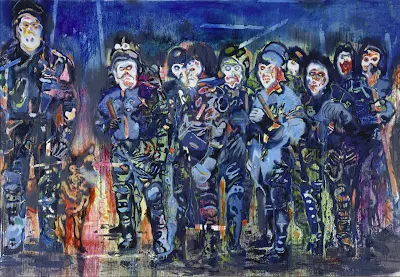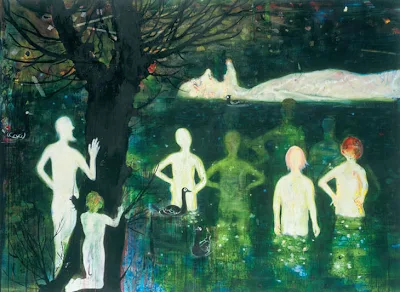Jawohl und Gomorrah (2001). Oil on canvas, 225 x 370 cm
Richter attended
Hochschule für bildendende Künste Hamburg from 1991-1995. Between 1992-1996 he
studied with Werner Büttner – one of the protagonists, along with Martin
Kippenberger, of the revival of expressive trends in painting during the 1980s
–, and worked as assistant to Albert Oehlen. Between 2004 and 2006 he served as
Professor for Painting at the Universität der Künste, Berlin. Since 2006, he
has been teaching at Akademie der bildenden Künste, Vienna. He is married to director Angela Richter.
Rag Mal Eine Frau, 2009
Initially, Richter
did abstract paintings, with a cosmos of forms intensely colourful to the point
of being psychedelic – somewhere between graffiti and intricate ornamentation.
Since 2002 he has painted large-scale scenes filled with figures, often
inspired by reproductions from newspapers or history books.
.jpg)
Die Idealisten (2007-2008)
Within a stone’s
throw of Daniel Richter’s studio in the funky neighborhood known as Mitte, the
Berlin Biennale has laid out an international smorgasbord of artists, curators,
dealers and critics. But the scraggly-haired, athletically built Richter—whose
giant, cacophonous paintings overflow with exuberant graffiti scrawls, gobs of
Day-Glo color and ghoulish references to Goya, Ensor and Munch—is deliberately
steering clear of the action. From a window in the Gothic-style former
postal-service carriage house where he has lived and worked in relative quiet
for 10 years, the artist spots a journalist roaming a dilapidated courtyard and
raps lightly on the darkened pane. Moments later he emerges—towering,
unshaven—in a blue flannel bathrobe, pajamas and paint-speckled soccer shoes.

Dog Planet
Richter, 46, burst
onto the already spirited German painting scene in 1995 with his first solo
show, at the Contemporary Fine Arts Gallery (CFA), in Berlin, including works
such as Love, whose colorful, free-form style evinced a fascination with punk
rock and the album covers of R. Crumb and Raymond Pettibon. Four years later,
Richter’s abstract squiggles and pinkish tones began to assume the shapes of
faces in a crowd as he segued into figuration. But it wasn’t until 2000, when
Phienox and Tuanus, also first displayed at CFA, revealed his keen grasp of
color and dappled-light effects, that Richter’s meteoric ascent in Germany
translated into a quick succession of gallery shows.

Duisen (2004)
Enthusiasm for his
work continues to grow. A sold-out show of Richter’s most recent paintings and
drawings at Los Angeles’s Regen Projects this past February was followed a
month later by an exhibition of new work, also sold out, at David Zwirner
Gallery, in New York. This month, “Daniel Richter: A Major Survey” opens at
Denver Art Museum, ending a tour that began in Hamburg and included stops in
the Hague and Málaga, Spain.
Horde, 2007
The midcareer
retrospective, which includes 25 large-scale paintings and nearly 40 smaller
works from 1994 to the present, will finally give the artist broad
institutional exposure in the United States. Organized by Denver’s recently
appointed curator of modern and contemporary art, Christoph Heinrich, the
exhibition rides a wave of international interest in contemporary German
painters, among them Neo Rauch, Franz Ackermann, Thomas Scheibitz and now
Richter.

Im Birkengrund
Richter often uses
news photographs as sources for his work, and evidence of his reading
preferences—from leaning towers of newspapers and magazines to existential
novels—clutters the dining table of his small kitchen adjacent to the studio.
He loves talking politics and unselfconsciously spouts provocative opinions.
That said, the imagery of his best-known history paintings— friezelike
depictions of comic-book superheroes, burlesque dancers, dogs and zombies
confronting policemen—defies easy interpretation.
.jpg)
Jeans (2002)
The same is true of
his more recent portraits of solitary instrumentalists and soldiers, whose
fuzzy edges and shadows render guitars and guns interchangeable. “One minute,
you have the melancholic blues folk musician, the heroic poor guy,” he says.
“The next, you have the lost soul of a soldier entering a vast enemy area.”
Presented from the rear, the figures in this series are stooped, abject, like
prisoners awaiting their own execution but, says Richter, only half accepting
their fate.
Les Paul Dictatorship, 2008
With its 30-foot
ceilings and persistent damp chill, Richter’s studio has the feel of a giant
garage, and in fact, the building was an auto body shop after it was abandoned
by the post office. Overlapping Persian carpets do little to warm things up. A
series of dark rooms off his studio reveals an unmade bed and shelves cluttered
with books and records.
Mahnungen, 2008
It’s as if his real
life exists elsewhere— which in some ways it does. After working in monk-like
seclusion for two- to three-week periods, he joins his wife, Angela, a theater
director, and their toddler son at their home in Hamburg for several days—or
weeks—of rest. After this much-needed domesticity, he returns to Berlin to
start the cycle all over.
Still. 2002. Oil and Ink on Canvas. 280 x 380 cm
Two enormous
whitewashed wooden panels run the length and width of the cavernous space. In
the room’s center, a single, swiveling office chair, its seat padded with a
thick wool blanket, offers the perfect vantage from which to view an enormous
painting in progress hanging from the smaller of the two panels.
The Owner’s Historic Lesson
WE'LL NEVER STOP LIVING LIKE THIS, 2009
Trevelfast, 2004
Like a witness to
Richter’s many contradictions, the picture features neither guitar hero nor
soldier but a burning hand suspended before a horrified man in a blue suit and
a frieze of fluorescent skeletons.





.jpg)





.jpg)









